The field of astronomy has long been at the forefront of technological advancement, with scientists constantly pushing the boundaries of what is possible in our understanding of the universe. In recent years, artificial intelligence (AI) has emerged as a powerful tool in the astronomer’s toolbox, offering new insights and breakthroughs in our understanding of the cosmos. From identifying new planets to analyzing vast amounts of data, AI is transforming the way we study the universe. In this blog post, we will explore the top-10 tech-tips on how AI is used in astronomy, highlighting some of the most exciting and innovative applications of this cutting-edge technology. Whether you are a seasoned astronomer or simply interested in the latest advances in science and technology, this post will provide a fascinating glimpse into the world of AI and its role in shaping our understanding of the universe. So, without further ado, let’s dive into the amazing ways that AI is being used to unlock the secrets of the cosmos.
1. Discovering new celestial objects
One of the top ways that Artificial Intelligence (AI) is used in astronomy is through the discovery of new celestial objects. AI algorithms can analyze vast amounts of data from telescopes and satellites, and identify patterns or anomalies that may indicate the presence of previously unknown objects, such as new planets, stars, or galaxies. This approach has already led to the discovery of numerous exoplanets, including some that are potentially habitable. With AI-powered tools, astronomers can process data much faster and more accurately than ever before, allowing them to uncover new insights and push the boundaries of our understanding of the universe. As more and more data is collected by telescopes and other instruments, AI is expected to become an increasingly important tool for discovering new celestial objects and advancing our knowledge of the cosmos.
2. Analyzing large data sets quickly
Analyzing large data sets quickly is one of the most significant challenges in modern astronomy. Traditionally, astronomers have relied on manual analysis of data, which can take years to complete. However, with the advent of Artificial Intelligence (AI), this process has become much quicker and more efficient. AI algorithms can analyze enormous data sets in a fraction of the time it would take a human, and they can often detect patterns and relationships that would be difficult or impossible for humans to discern. In astronomy, AI is used to analyze everything from images of galaxies to data from telescopes, and it is making it possible to explore the universe in ways that were previously impossible. Whether you’re a professional astronomer or just a curious amateur, understanding how AI is used in astronomy is essential to understanding the universe we live in.
3. Detecting exoplanets and their atmospheres
Detecting exoplanets and their atmospheres is an exciting area of research in astronomy that has been revolutionized by the use of Artificial Intelligence (AI). It involves analyzing massive amounts of data collected by telescopes to identify slight variations in the brightness of stars that could indicate the presence of a planet orbiting them. AI algorithms are used to sift through this data and identify planetary systems that may have been missed by traditional methods. Additionally, AI is utilized in the analysis of spectroscopic data to identify the chemical composition of exoplanet atmospheres. This allows scientists to learn more about the conditions on these planets and determine if they could support life. With the help of AI, astronomers are able to uncover new discoveries in the study of exoplanets and their atmospheres, and further our understanding of the universe.
4. Improving space exploration missions
Improving space exploration missions is one of the significant benefits of using Artificial Intelligence (AI) in astronomy. With AI’s ability to analyze vast amounts of data in real-time, it has become an indispensable tool in space exploration missions. AI is used to identify and interpret complex patterns in the data gathered from space telescopes, satellites, and rovers. Moreover, AI algorithms are used to optimize telescope operations by scheduling observations and reducing downtime. Additionally, AI-powered robotic systems are being developed to explore planets and moons, which can provide valuable insights into the history and evolution of the universe. By incorporating AI into space exploration missions, we can expect to achieve more significant scientific discoveries than ever before.
5. Identifying patterns in cosmic data
Identifying patterns in cosmic data is one of the most promising applications of artificial intelligence (AI) in astronomy. With the vast amount of data generated by modern telescopes and observatories, it has become increasingly difficult for human astronomers to sift through all the information and identify meaningful patterns or anomalies. AI algorithms can help automate this process by analyzing large datasets and identifying patterns that may not be obvious to the human eye. This can lead to new discoveries and insights into the nature of the universe, such as the detection of gravitational waves or the discovery of new exoplanets. However, it is important to note that AI is not a replacement for human expertise and interpretation, but rather a powerful tool that can augment and support the work of astronomers.
6. Enhancing telescope capabilities
The use of Artificial Intelligence (AI) has allowed for significant advances in the field of astronomy. One of the most promising applications of AI in astronomy is the enhancement of telescope capabilities. With the help of AI, telescopes can now capture and analyze vast amounts of data with greater accuracy and efficiency than ever before. This has allowed astronomers to study the universe in greater detail, detecting fainter objects and uncovering previously unknown phenomena. AI algorithms can also help in identifying patterns and anomalies in astronomical data, leading to new discoveries and insights about the universe. As AI continues to evolve, it is expected that telescope capabilities will further improve, leading to even more exciting discoveries and breakthroughs in the field of astronomy.
7. Assisting in cosmological simulations
Assisting in cosmological simulations is one of the most significant applications of Artificial Intelligence (AI) in astronomy. Cosmological simulations are used to model and understand the evolution of the universe by simulating the growth of cosmic structures such as galaxies, clusters of galaxies and dark matter. With the help of AI, cosmological simulations can be conducted with greater accuracy and efficiency, leading to better insights into the universe’s evolution. AI algorithms can analyze large datasets and identify patterns that would be difficult for human researchers to spot, speeding up the simulation process and enabling more precise predictions. Furthermore, AI can help automate the process of calibrating these simulations with observational data, making it easier to find the best-fit models. The use of AI in assisting cosmological simulations is an exciting development that will undoubtedly lead to breakthroughs in our understanding of the universe’s origins and evolution.
8. Providing real-time astronomical updates
One of the top 10 tech-tips on how artificial-intelligence-AI is used in astronomy is providing real-time astronomical updates. With the help of AI, astronomers can analyze vast amounts of data from telescopes and other instruments, and instantly identify significant changes in the night sky. This allows them to quickly follow up on potential discoveries, and capture important data that might otherwise be missed. Real-time astronomical updates also help astronomers better understand transient phenomena, such as supernovae, which can evolve rapidly over just a few days or weeks. AI-powered systems are essential for quickly identifying and tracking these phenomena, and can help astronomers better understand the nature of the universe around us. Overall, the ability to provide real-time astronomical updates is just one of the many ways in which AI is transforming the field of astronomy, and helping us unlock the secrets of the cosmos.
9. Enabling autonomous space exploration
Enabling autonomous space exploration is one of the most exciting applications of artificial intelligence (AI) in astronomy. With the help of AI algorithms, spacecraft can operate independently, making decisions based on data from sensors and cameras without requiring constant human intervention. This can significantly reduce the workload of mission control centers and enable more complex and longer-duration space missions. AI-enabled autonomous spacecraft can also adapt to changing environments and unexpected events, making them more resilient and able to handle emergencies. Furthermore, AI can help optimize spacecraft trajectories and resource management, minimizing fuel consumption and maximizing scientific return. As the technology evolves, we can expect to see more ambitious and innovative space missions enabled by AI.
10. Revolutionizing astronomical research methods
The use of artificial intelligence (AI) has revolutionized astronomical research methods, making it one of the top 10 tech-tips in the field. AI algorithms have allowed researchers to analyze vast amounts of astronomical data quickly and accurately, leading to new discoveries and breakthroughs. For instance, AI-powered tools enable the identification of patterns and anomalies in large datasets, enabling astronomers to find exoplanets, galaxies, and other celestial objects that were previously undetectable. Additionally, AI can help astronomers analyze images, classify astronomical objects, and predict their behavior. By automating these tasks, AI technology frees up valuable time for researchers to focus on analyzing data that is more complex and requires human attention. Overall, AI has transformed the way we conduct astronomical research, and its impact will continue to grow in the coming years.
In conclusion, the use of Artificial Intelligence (AI) in Astronomy is rapidly expanding and revolutionizing the field. From identifying new celestial objects to predicting the behavior of stars, AI is proving to be a valuable tool for astronomers. As new advancements in AI technology continue to emerge, we can expect to see even more exciting developments in the field of astronomy and space exploration in the years to come. With the continued integration of AI and data science, we can look forward to unlocking more secrets of the universe and expanding our knowledge of the cosmos.


